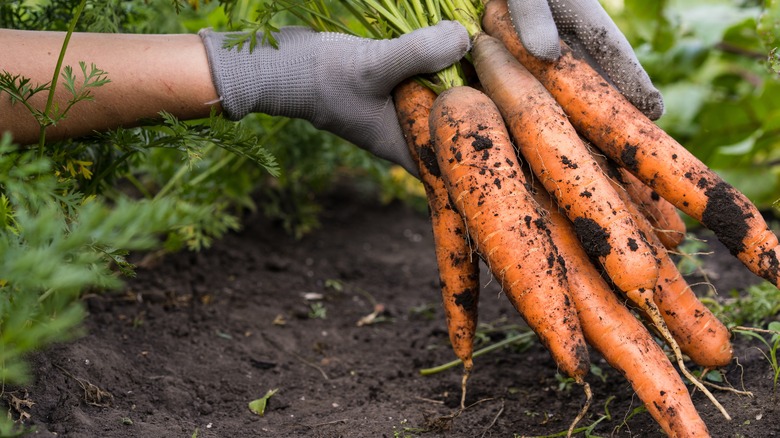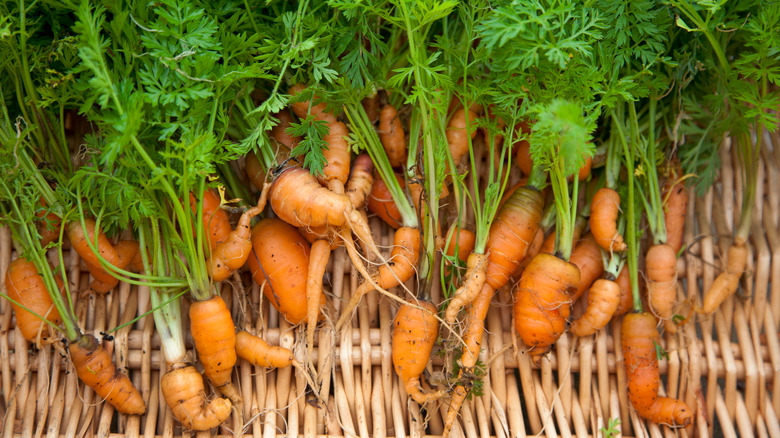TikTok Shares The Key To Growing Perfect Carrots For A Delicious Harvest
Carrots (Daucus carota var. sativa) are biennial plants in the Apiaceae family, commonly cultivated for their enlarged, sweet, and colorful roots. Native to Central Asia, carrots are rich in carotenoids, vitamins, and minerals and are enjoyed as a staple in many diets worldwide. It is possible to successfully grow carrots in containers or directly in the ground, making them a popular choice for beginner and experienced gardeners alike. While these cool-season vegetables are relatively easy to grow, TikTok shares that the key to growing healthy carrots is choosing the right soil — light, well-aerated soil will provide the ideal conditions for perfect carrots.
In the first growing year, carrot plants produce a rosette of pinnately divided leaves with a lacy appearance. The plant flowers in its second year; however, carrots are commonly grown as annuals and harvested for their enlarged taproot in the first year. The white umbel flowers are similar to other plants in the Apiaceae family, such as parsley, celery, and angelica. The first known domesticated carrots were purple and white, but over time, a mutation removed the purple pigmentation and gave rise to yellow carrots. Yellow evolved into the orange roots that we are familiar with today. However, cultivars are available in shades from orange to yellow and deep purple.
Why do carrots need light and airy soil?
Carrots require a loose soil structure so the root can easily and efficiently push through. In compacted soil, the carrot may become forked, stunted, or unable to reach its full length. A loose, well-aerated structure will allow water to disperse evenly, accessing the carrot crop and preventing waterlogging. Sandy and silt loam soils are the best options for growing carrots. If your garden has heavy clay, consider planting your carrots in containers or starting a raised bed garden. There are also shorter cultivars, such as Daucus carota 'Chantenay,' that are suited to heavy soils.
Alongside choosing the right soil, carrots require a regular watering schedule for optimum growth. Drought can decrease the yield and cause the plant to become stressed and more susceptible to infection. In water-saturated conditions, the taproot may become stunted, discolored, or develop root rot. Note that it is important not to over-fertilize your carrot crop, as too much nitrogen can produce forked carrots. Growing your carrots in well-draining soil and providing consistent moisture will ensure the best environment for a successful harvest.
How to grow carrots from seed
Carrots should be direct-seeded rather than started in seedling trays — carrot seedlings don't respond well to transplanting as it can damage or misdirect the developing roots. The carrot sowing season is in the spring after the soil reaches 40 degrees Fahrenheit. If sowing directly in the garden, trace rows 12 to 18 inches apart and plant the seeds at only ¼ inch deep. For container planting, choose a large pot at least 10 inches deep, providing sufficient room for the roots to grow. Fill the container with soil, scatter the seeds on the surface, and cover them with a fine layer of soil or sand. TikTok suggests covering the surface of your container with a sheet of cardboard. This tip can protect the seeds during periods of excessive rain and help maintain moisture. Make sure to check under the cardboard daily and remove it once the seeds begin to sprout.
Grow carrots in full sun and keep the soil consistently moist. The seedlings should emerge within 14 to 21 days in temperatures between 55 and 65 degrees Fahrenheit. Thin out the small, grass-like seedlings once they have developed 2 to 3 true leaves or are large enough to handle — aim for a final spacing of around 1 to 3 inches between each seedling. Depending on the growing environment and cultivar, the roots can take 70 to 120 days before they're ready for harvest.

